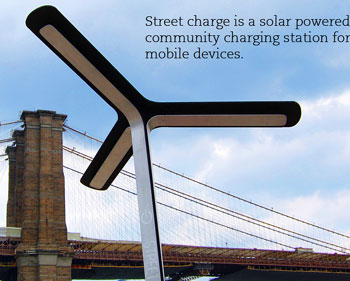Mobile Solar Gets a Big Lift
Utility NRG Energy announced it’s acquiring Goal Zero to bring mobile solar energy into the mainstream.
With smartphone batteries constantly needing a charge, people often select seats at restaurants or airports based on where the outlet is. NRG sees an opening to "free people" through solar charging.
Goal Zero lucked out. Founded in 2009, it sells solar charging devices for the outdoor market – hikers or mountain bikers, for example. Revenues have grown from $250,000 to $40 million – with 120 employees – and with NRG, they will make a bigger leap than they imagined possible.
While most utilities are currently at war with renewable energy, NRG leads on solar and wind, and recently spun off NRG Yield.
Street Charge in NYC
Last year, AT&T began installing solar-powered charging stations in New York City boroughs at parks, beaches and other outdoor spaces. 12 feet tall, they look like flattened windmills, designed by NYC-based Pensa and running on Goal Zero’s solar technology.
Each of three blades is topped with 15-watt solar panels and inside is a 168-watt per hour lithium battery pack. They can operate for five days without sunshine.

Six devices – from any carrier – can be charged simultaneously. People can get their smartphone 30% charged in a half-hour or completely charged in two hours.
People know how much charge they need for say, the commute home, says Chris Abbruzzese of Goal Zero, based on their market research.
"People are making less phone calls than they’ve made before and more importantly the newer generation are really not making many phone calls. To make money out of data services the telecom companies need to convince you to connect as many devices as possible. The more you connect, the more data you use, the more money they make," Eddie Hold, vice president with market research firm Connected Intelligence, told the NY Times.
Park Benches in Boston
In Boston, some park benches are doubling as solar cell-phone and tablet chargers.
"Your cell phone doesn’t just make phone calls, why should our benches just be seats?," asks Mayor Walsh of Boston during an interview with The Washington Post.
That’s where a pilot is underway, where "Soofa" benches charge devices and connect wirelessly to the Internet, streaming information on local air quality, foot traffic, and how much energy is being generated.

Made from concrete, sheet metal, and wood, the chargers are designed to prevent hacking, a potential problem with public access USB ports. The boxes are closed with security screws and if an axe was used the electronics would be useless.
The innovation comes from a start-up called Changing Environments, spun-off from MIT’s Media Lab and debuted in June at the White House Maker Faire in Washington, DC., where entrepreneurs are invited to show off their inventions.
"We were thinking about how can we change public opinion to accept more solar … and start a dialogue about air quality in cities and renewable energy," explains Sandra Richer to BloombergBusinessweek. She is one of the three co-founders – all from Germany.
Verizon is backing them with technical support and Cisco Systems paid for Boston’s first benches.
Other cities are already calling for benches.
++++
The idea of mobile solar has taken off since Hurricane Sandy, when it became evident how important it is.
Read our article, Green Technology Spotlight: Mobile Solar.

very mixed feelings about this idea. part of it is aesthetic, part a class consciousness surrounding the digital divide. Not sure I’d want park bench space that favors e-chargers over peoples’ butts. Maybe I’m missing something in the translation,Ms.. Editor?